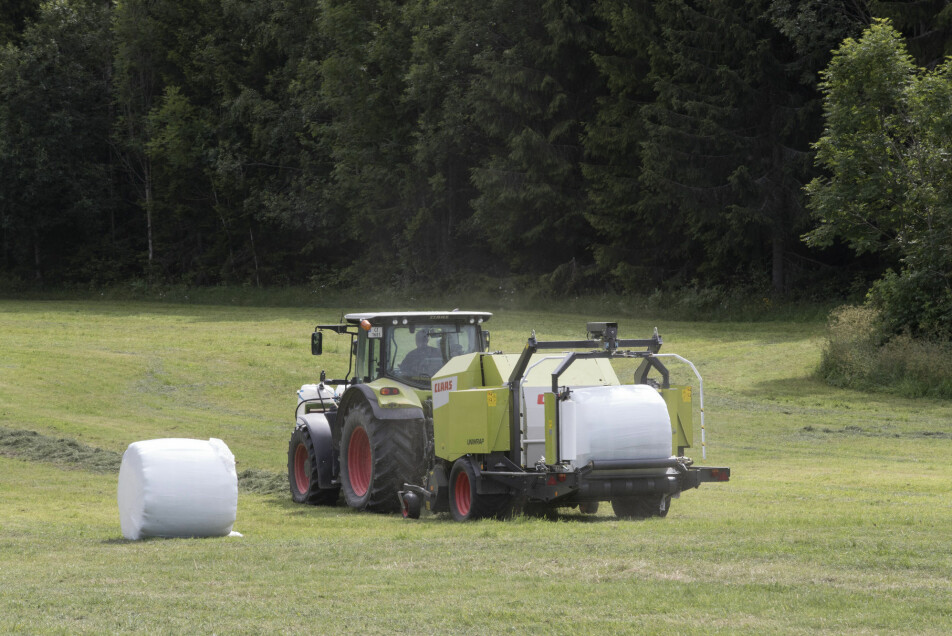
Weight gain in the population is not due to less exercise
Physical activity at work and in our leisure activities has had little or no impact on the increase in the average Norwegian's BMI in recent decades, according to two new studies. So why the increase in weight?
We’ve gotten fatter.
Since the 1980s, people’s body mass index, or BMI, has increased in all segments of the population. Today, about 70 percent of Norway’s population is overweight or obese. This is also the case in many other countries around the world.
What’s happened?
A common refrain is that one of the main reasons for the gradual increase in weight is that we are moving less now, both in our free time and at work.
However, much of the research in recent years does not support this view. Admittedly, there’s plenty of evidence that our jobs have become less physically demanding. However, the connection between our level of activity and developing overweight or obesity is missing.
Now the results of two new Norwegian studies confirm that less activity in the workplace or in our free time doesn’t appear to be the culprit in the increase in BMI.
On the contrary, the results suggest a connection in the opposite direction: weight increase seems to lead to less physical activity.
Examined changes in activity
“Numerous researchers have tried to investigate the connection between physical activity and BMI in recent decades,” says Edvard Sagelv from UiT Norway's Arctic University, one of the researchers behind the two studies.
“But we’ve expanded the studies by looking at people’s change in physical activity and whether we can observe a link between change in physical activity and BMI.”
The researchers used data from the Tromsø survey, a large population survey that has collected information on many thousands of Tromsø residents since 1974. People have participated in the surveys and answered comprehensive questionnaires about their work and leisure time at six-year intervals.
Sagelv and his colleagues first looked at data on the participants’ activity at work.
All groups’ BMI increased equally
In recent decades, technological development has made many jobs easier, and more people have sedentary jobs. At the same time, of course, some people change jobs to positions with greater or less physical activity.
The researchers sorted the Tromsø survey participants into four groups. The categories were:
- people who had sedentary jobs the whole time
- people who had active jobs the whole time
- people who changed from a sedentary to an active job and
- people who went from an active to a sedentary job.
What happened to participants’ BMI in the various groups between 1974 and 2016?
Their results were exactly the same!
The BMI in all the groups increased by approximately 0.85 BMI points.
It turned out not to be the case that a job with a lot of physical activity protected against the increase in BMI, or that people who switched from an active job to a sedentary one put on more weight than the others.
The researchers write that their findings do not support the hypothesis that a decrease in physical activity at work has contributed to the BMI increase in the population over the last few decades.
But could physical activity have a greater effect for how people spend their free time?
No effect from exercise, either
Sagelv and his colleagues also used the Tromsø data to investigate this question. In this study, participants were again divided into the same four groups according to their physical activity level, as was done in the study of physical activity at work.
The results were very similar to the outcome of the first survey: the researchers found no correlation between people’s leisure activity and BMI development.
The study thus suggests that a high level of exercise does not protect against weight gain, nor that little physical activity increases the risk. Nor do people who go from low to high levels of activity reduce their risk of increased BMI.
However, Sagelv emphasizes that these results apply to the average population.
“Individuals may have different results,” he says.

In any case, exercise and training are good both for people’s mental and physical health.
“Physical activity and exercise have major positive health effects. But if the goal is weight loss, the answer lies elsewhere,” Sagelv says.
Increased weight results in less activity
The data from the Tromsø survey thus showed no signs that less activity results in increased BMI. On the contrary, the survey points to a different correlation:
Increased BMI seems to lead to less activity.
This is also in line with previous studies, Sagelv says.
“This is a more distinct trend in all the studies that have been done: when people’s weight increases, their activity level decreases.”
In one study, researchers measured how much a group of people walked in everyday life. Then the researchers had the participants eat 1000 calories more a day for eight weeks. This led to the participants putting on weight, while their walking pace became slower and the trips shorter.
However, the participants spent the same amount of energy on this activity, says Sagelv.
This finding is in line with other studies of the body’s energy metabolism. Precise studies have shown that an overweight person spends more energy than a normal-weight person on the same activity.
It’s possible that overweight people thus maintain the amount of energy they expend while exercising even if their activity level decreases.

Weaknesses
The two studies from Tromsø have some weaknesses.
For example, the information about physical activity at work and in people’s free time is self-reported. Often people tend to report more exercise than they actually did.
Another limitation is that the researchers do not have any information about what the participants ate. The division into four categories of activity is a coarse grouping, and finer divisions might have revealed differences in some subgroups.
These studies were not conducted as randomized controlled trials, where two parallel groups of people are assigned different activity levels. Other factors that might have influenced the result thus cannot be completely ruled out.
Despite these weaknesses, Professor Bård Kulseng at NTNU finds the study interesting.
Other factors given increased attention
“The results are exciting, and they’re in line with other studies that have looked at physical activity and obesity,” he says.
Kulseng has researched obesity for many years but did not participate in the two studies from Tromsø.
“The results from Tromsø lend focus to the idea that we should look at other things that could be drivers of the obesity epidemic,” he says.
The researchers behind the studies likewise conclude that measures to prevent weight gain would be more successful if they focused on other factors than only physical activity.
The question is clearly: What are other factors?
Are we eating more?
A natural place to look is food intake. Are we just eating more? After all, food has never been more available than today.
A study from the USA shows that calorie consumption there increased by around 500 calories a day from the 1970s to the 2000s. Similar figures emerged in a survey from Western European countries.
These are figures that have been published in peer-reviewed journals and are thus quality assured.
However, eating habits and food offerings differ dramatically from country to country. It is difficult to say how well figures from the USA reflect developments in other countries.
Norwegian figures show no increase
Statistics on the Norwegian diet are also available, but they have not been published in scientific journals. The figures can be found in the report "Developments in the Norwegian diet" (in Norwegian) from the Norwegian Directorate of Health.
The data comes from statistics on food supply in Norway – the sum total of food available to the population. Regular surveys are also conducted on what people in households shop for.
Those figures indicate that the calorie intake in Norway has not increased in recent decades, but instead has actually decreased slightly.
“These statistics aren’t necessarily worse than the published studies, but it’s hard to know,” says Sagelv.
Measuring energy intake in the population is generally very difficult, according to the researcher. Nevertheless, this is one of the topics that should be researched more in the future.

Could there be other reasons?
Sagelv doesn’t rule out that other mechanisms might be having an effect. He wonders whether hormonal changes or other factors maybe play a role.
Kulseng goes a step further. He thinks the answers are much more complicated than individuals just choosing to eat more.
For example, a study at NTNU compared weight gain in people with genes that made them vulnerable to obesity, and people without such genes.
In the 1960s, there was almost no difference in weight between people with vulnerable genes and those without. However, later studies showed that almost only individuals with vulnerable genes had increased BMI.
“This indicates that something in the environment has changed, something besides people’s will forces,” says Kulseng.
“We need to look at what’s changed in the environment since the early 1980s.”
Pollution and nanoplastics
The obesity epidemic around the world has coincided with major changes in the environment. One example is how we surround ourselves with other fabrics than before, in the materials we use in clothing and in other products.
Kulseng thinks we need to look more closely at the pollutants in substances that may affect the body.
“Plastic micro- and nanoparticles that we ingest via food and air raise a lot of questions. You have to wonder if these particles can set off inflammatory reactions that might affect insulin levels and appetite regulation,” he says.
Kulseng remembers results from the doctoral work he did in his time.
He studied how the bodies of mice reacted to substances in alginate spheres, a carbohydrate extracted from seaweed and kelp. It turned out that some of the alginate spheres caused inflammation in the mice, depending on the type and quality of the alginate.
“In some of the mouse studies, the spheres that were inserted into the abdominal cavity were eventually enclosed by newly formed adipose tissue. We surmised that this was due to an inflammatory reaction that transformed fibroblasts into fat cells,” says Kulseng.
View of obesity oversimplified
Kulseng plans to start new studies at NTNU to look more broadly at what can affect the development of overweight and obesity.
“We need to move away from thinking that obesity is due to one thing. We have to think in a multifactorial and individual way. One factor might affect some people and another might affect others.
Kulseng believes that the view of obesity has been simplified far too much, and that the wrong basis has been used in developing obesity prevention measures.
“Up to now the spotlight has been put on individuals, who have been told to exercise more and eat less. We haven’t been able to look at the big picture,” he says.
“But the new studies from Tromsø can serve as impetus to consider other causes.”
Translated by Ingrid Nuse.
Read the Norwegian version of this article on forskning.no.
References:
E. H. Sagelv, U. Ekelund, L. A. Hopstock, N. A. Aars, M. S. Fimland, B. K. Jacobsen, O. Løvsletten, T. Wilsgaard, B. Morseth, Do declines in occupational physical activity contribute to population gains in body mass index? Tromsø Study 1974–2016, BMJ Occupational and Environmental Medicine, desember 2020.
E. H. Sagelv, U. Ekelund, L. A. Hopstock, M. S. Fimland, O. Løvsletten, T. Wilsgaard & B. Morseth, The bidirectional associations between leisure time physical activity change and body mass index gain. The Tromsø Study 1974–2016, International Journal of Obesity, mai 2021. Sammendrag.































